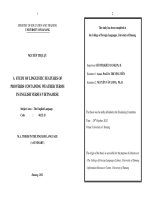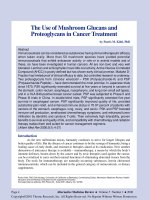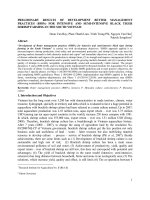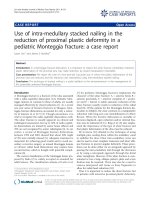Use of ITS DNA barcode for identification of Jewels of Opar (Talinum paniculatum) collected in Thanh Hoa, Vietnam
Bạn đang xem bản rút gọn của tài liệu. Xem và tải ngay bản đầy đủ của tài liệu tại đây (1.3 MB, 4 trang )
Life Sciences | Pharmacology, Biology
Use of ITS DNA barcode for identification
of Jewels of Opar (Talinum paniculatum)
collected in Thanh Hoa, Vietnam
Thi Ngoc Lan Nguyen1, Huu Quan Nguyen1, Thi Hanh Nguyen2, Thi Mai Thu Lo3, Hoang Mau Chu1*
2
1
Thai Nguyen University of Education
Thanh Hoa Department of Education and Training
3
Tay Bac University
Received 11 July 2017; accepted 10 November 2017
Abstract:
Introduction
Jewels of Opar (Talinum paniculatum) is a herbaceous
plant known for its highly medicinal value. This medicinal
plant is listed in the Red List of Vietnam’s medicinal
plants and in the handbook of Vietnam’s medicinal plants,
both documents warranting its necessity for protection.
Jewels of Opar contains bioactive substances such as
phytosterols, saponins, flavonoids, tannins, steroids, and
many other inorganic substances. Jewels of Opar plants
collected in Thanh Hoa, Vietnam, are tree-like herbs,
their green trunks grows straight up and then branch
out. The shapes of the leaves vary; they are generally oval
or ovate-oblong in shape, with wavy veins. The flowers
of this tree have five reddish purple wings, two sepals,
more than ten stamens, and a spherical ovary. Both the
fruits and their seeds are small and black. Tuberous roots
are cylindrical with many small roots, and the tubers
themselves are sweet and spicy. Internal transcribed
spacer (ITS) region isolated from T. paniculatum plants
in Thanh Hoa, Vietnam is 643 bp in length. Based on
the nucleotide sequences of the ITS region and using the
basic local alignment search tool (BLAST) in the National
Center for Biotechnology Information (NCBI), the Jewels
of Opar samples collected in Thanh Hoa, Vietnam were
determined to belong to T. paniculatum species, Talinum
genus, Portulacaceae.
Jewels of Opar (T. paniculatum Gaertn or T. crassifolium
Willd or T. patens L.) is a species in the Talinum genus of the
Portulacaceae. A herbaceous plant, it is well known for its
medicinal value. Jewels of Opar is one of the medicinal plants
included in the Red List of Vietnam medicinal plants and in
the handbook of Vietnam’s medicinal plants as a species that
should be protected at the vulnerable level (VU A1A, c, d)
[1]. Jewels of Opar contains substances such as phytosterols,
saponins, flavonoids, tannins, steroids and several other
inorganic substances. These substances have anti-viral effects
and are very effective on Herpes’ disease and skin infections.
Besides, they can also be used as a supporting medicine for
Parkinson’s disease and heart disease and for lowering blood
cholesterol... [2].
Keywords: DNA barcode, ITS marker, Jewels of Opar,
medicinal plants, Talinum paniculatum.
Classification numbers: 3.3, 3.4
Currently, the identification of medicinal plants has been
mainly based on morphological analysis. However, this method
often encounters obstacles when the raw plant material has
been completely or partially processed. According to Hebert,
et al. (2003), the DNA barcode is one of the methods used as a
method to identify the species. Some DNA regions within the
nucleus genome and the chloroplast genome have been used in
the identification of plant species [3]. The nucleus rADN genes
are a multi-gene system coding for rRNA sequences that are
both conservative and diverse when it comes to distinguishing
close species. In the nucleus of the cell, rADN are arranged
as random units, including DNA encoding 18S, 5.8S, 28S
ribosomal RNA and alternating between non-encoding
sequences ITS1 and ITS2 (internal transcribed spacers) located
on either side of the 5.8S gene segment [4-6]. The coding
sequences of three rADN genes, 18S, 5.8S, 28S, are more
conservative than the sequences of ITS1 and ITS2. Currently,
the ITS region of the nuclear genome is considered to be one
of the most useful tools for identifying and evaluating plant
phylogeny [7]. In this work, the researchers present the results
of using the ITS DNA barcode to identify the Jewels of Opar
samples collected from Quan Hoa district and Bim Son town
of the Thanh Hoa province of Vietnam.
Corresponding author: Email:
*
46
Vietnam Journal of Science,
Technology and Engineering
March 2018 • Vol.60 Number 1
Life Sciences | Pharmacology, Biology
Material and methods
The Jewels of Opar (T. paniculatum) samples collected from
Quan Hoa district and Bim Son town (Thanh Hoa province)
were used for morphological and DNA barcode analysis.
The identification of T. paniculatum plants was done
according to the method suggested by Nguyen Tien Ban
(2013) [8] and Pham Hoang Ho (1999) [9]. The total DNA was
isolated from young leaves based on the method proposed by
Shaghai, et al. (1984) [10]. The amplification of ITS region by
PCR with primer pair ITS-F/ITS-R was synthesized according
to Kress, et al. (2005) [11]. The expected size of the amplified
DNA fragment is 665 bp in length.
The
ITS
primer
sequences:
ITS-F:
5’
ACGAATTCATGGTCCGGTGAAGTGTTCG 3’; ITS-R: 5’
TAGAATTCCCCGGTTCGCTCGCCGTTACT 3’.
The thermal cycle of PCR occurs after the initial 940C
denaturation step over a duration of 4 minutes. The reaction
was carried out followed over 40 cycles at 940C for 30 seconds,
580C for 60 seconds (annealing), 720C for 60 seconds, and
a final extension 720C for 10 minutes. The PCR products
were detected by electrophoresis on 1.0% agarose gel. Later,
QIAquick Gel Extraction Kit was used to purify the PCR
products.
The nucleotide sequence of the ITS region was determined
by the ABI PRISM® 3100 sequencing Avant Genetic Analyzer
using the BigDye® Terminator v3.1 Cycle Sequencing Kit.
The ITS nucleotide sequence was analyzed using BLAST,
BioEdit, and DNAstar software.
Results and discussion
Morphological characteristics of Jewels of Opar (T.
paniculatum) plants
B
AA
AA
BB
CC
C
DD
EE
HH
GG
Fig. 1. Morphology of Jewels of Opar (T. paniculatum).
(A): Jewels of Opar plant; (B): branches bearing flowers;
(C): branches bearing fruit; (D, E): buds and flowers; (G):
sliced fruit; (H): seeds.
An analysis of the growth and development of Jewels of
Opar from seedling to flowering stage show that the seeds
started to germinate after 6-7 days of their cultivation and the
first leaves appeared after about 15 days. After 50 days, the
roots of Jewels of Opar began to bulge and produce tubers.
From the 65th day onwards, Jewels of Opar went on to produce
flowers and fruits (Fig. 2).
Figure 1 presents the morphological characteristics of
Jewels of Opar. Jewels of Opar is a tree-like herb that grows
straight up to about 30-50 cm in height. The trunk is green,
smooth, and branching at the bottom. The leaves of Jewels of
Opar are staggered; they are generally oval, ovate-oblong, or
egg back shaped. They are thick, glossy, and wavy vein, without
hairs. The flowers of the plants have five reddish purple wings,
two sepals, more than ten stamens, and a spherical ovary. The
fruits are small, and the ripe fruit is ash gray in color. The seeds
are very small, slightly flat, and black. The tuberous roots are
cylindrical, with many small dark brown roots. The shape of
the tuber resembles a humanoid. The tubers are about 3-6 cm
long and pinkish white. On drying out, the tubers turn black in
color. Both the roots and the tubers are sweet and spicy.
Fig. 2. The growth and development of Jewels of Opar. (A):
15-day-old seedling; (B): 40-day-old plant; (C): the roots
began to bulge and produce tubers after 50 days; (D): the
plant started to flower and produce fruits after 65 days; (E):
tubers of 113-day-old Jewels of Opar.
The seeds of Jewels of Opar collected from Quan Hoa
district and Bim Son town (Thanh Hoa) were cultivated and
analyzed on the basis of the morphological characteristics of
roots, tubers, stems, leaves, flowers, fruits, and seeds (Fig. 1).
According to Do Tat Loi, Jewels of Opar is a wild,
herbaceous plant. The plants are cultivated in many places
because of the medicinal value they carry [12]. Jewels of Opar
are distributed across many localities such as Ha Giang, Tuyen
A
B
March 2018 • Vol.60 Number 1
C
D
Vietnam Journal of Science,
Technology and Engineering
E
47
Life Sciences | Pharmacology, Biology
Quang, Hoa Binh, Lang Son, Cao Bang, Hai Phong, Thanh
Hoa, and Nghe An... [9, 12]. Jewels of Opar can be planted by
using the seed or the root. They are fast-growing trees, they
can be harvested after a year, and the perennial Jewels of Opar
will have larger tubers. Thus, it can be determined through
the analytical results of the morphological characteristics
and monitoring of growth and development of Jewels of
Opar that the samples collected from Bim Son and Quan Hoa
(Thanh Hoa) belong to the species T. paniculatum. Based on
morphological characteristics, Pham Hoang Ho (1999) [9] and
Do Tat Loi (2004) [12] classified Jewels of Opar as a type of
ginsengs called Dong Duong ginseng. Its scientific name is T.
paniculatum, belonging to Talinum genus, the Portulacaceae,
Caryophyllales, and Magnoliopsida. However, if the plant is in
its growing stage without flowers, it is easy to confuse it with
the same species of T. fruticosum. In addition, the classification
of Jewels of Opar encounters obstacles if the plants have been
completely or partially processed. As a result, it is necessary
to use an extra method and criterion for the classification.
The DNA barcoding method with the ITS region can be used
to accurately identify the Jewels of Opar samples without
confusion with other herbs.
Characteristics of the ITS region isolated from Jewels of
Opar plants
The total DNA was extracted from the leaves of Jewels of
Opar and used to perform PCR with ITS-F/ITS-R primer pairs.
PCR products were separated by electrophoresis on agarose
gel with 1 kb DNA marker. The results showed that the PCR
products of all samples obtained a DNA band of about 0.65
kb in size, which was similar to the predicted size of the ITS
region (Fig. 3).
1
2
3
0,65 kb
4
Fig. 4. Analytical results of similarities between ITS
sequences of Jewels of Opar samples from Bim Son and
Quan Hoa (Thanh Hoa, Vietnam) compared with four ITS
sequences in GenBank by BLAST tool.
As can be seen in Fig. 5, the comparative analysis of two
ITS nucleotide sequences isolated from the Jewels of Opar
samples collected from Bim Son and Quan Hoa (Thanh Hoa,
Vietnam) and the ITS sequence with an accession number
EU410357 in GenBank showed that there were 19 different
nucleotide positions. If the ITS sequence with an accession
number EU410357 in GenBank is used as the reference gene
region, the mutation may be an explanation for the changes in
the two ITS sequences isolated from the Jewels of Opar samples
(Thanh Hoa, Vietnam), specifically T or G substituted for A;
A or C substituted for G; G or T or A substituted for C; G or A
substituted for T.
M
0,75 kb
0,5 kb
Fig. 3. PCR analysis of ITS region from genome of Jewels
of Opar (M: DNA marker 1 kb; 1, 2: PCR products of two
Jewels of Opar samples collected from Quan Hoa, Thanh
Hoa; 3, 4: PCR products of two Jewels of Opar samples
collected from Bim Son, Thanh Hoa).
The PCR products of ITS region were purified and then
were sequenced. The results of the sequencing indicated an
ITS segment of 643 bp in size. Using the BLAST tool in NCBI,
the ITS sequences isolated from Jewels of Opar in Thanh Hoa
province of Vietnam were 97-98% homologous to the three
ITS sequences of T. paniculatum in GenBank, which had an
accession number JF508608 [13], EU410357 [14], and L78094
[15]. The plant shares a 93% similarity with the ITS sequence
of the T. fruticosum, Talinum genus with an accession number
KJ380908 [16] in GenBank (Fig. 4).
48
Vietnam Journal of Science,
Technology and Engineering
Fig. 5. Two ITS nucleotide sequences isolated from Jewels
of Opar samples collected in Bim Son and Quan Hoa
(Thanh Hoa, Vietnam) and the ITS sequence having an
accession number EU410357 in GenBank.
March 2018 • Vol.60 Number 1
Life Sciences | Pharmacology, Biology
Thus, it can be concluded that the ITS region isolated from
the Jewels of Opar samples from Bim Son and Quan Hoa
(Thanh Hoa, Vietnam) is the ITS region of T. paniculatum
species. The ITS sequences have been published in GenBank
with the accession numbers LT853590.1 and LT853591.1.
Fig. 6 shows the diagram of an ITS region isolated from T.
paniculatum plants in Thanh Hoa, Vietnam.
18S rDNA
ITS1
5.8S rDNA
ITS2
28S rDNA
ITS region
Fig. 6. An ITS region of T. paniculatum in Thanh Hoa,
Vietnam.
Genetic relationship among the species of the Talinum genus
An analysis of the genetic relationship between the species
of Talinum genus was based on the nucleotide sequences of the
ITS region in GenBank [17]. DNAstar software was used to
establish a phylogenetic tree of the genetic relationship among
T. paniculatum samples (Fig. 7).
B
II
REFERENCES
[1] Nguyen Tap (2007), Handbook of medicinal plants need protection in Vietnam,
Vietnam National Non-Timber Forest Product Publisher, Hanoi (In Vietnamese)
[2] Catthareeya Thanamool (2012), “Effects of T. paniculatum (jacq.) gaertn.
extracts on reproductive functions in female rat”. A Thesis Submitted in Partial
Fulfillment of the Requirements for the Degree of Doctor of Philosophy in Biomedical
Sciences, Suranaree University of Technology Academic.
[3] P.D.N. Hebert, C. Alina, L.B. Shelley, R. Jeremy (2003), “Biological
identifications through DNA barcodes”, Proc. R. Soc. Lond. B, 270(1512), pp.313-321.
[4] S. Chen, et al. (2010), “Validation of the ITS2 region as a novel DNA barcode
for identifying medicinal plant species”, PLoS ONE, 5(1), e8613, doi: 10.1371/
journal.pone.0008613.
III
[5] C. Van den Berg, W.E. Higgins, R.L. Dressler, W.M. Whitten, M.A. Soto
Arenas, A. Culham, M.W. Chase (2000), “A phylogenetic analysis of Laeliinae
(Orchidaceae) based on sequence data from nuclear internal transcribed spacers (ITS)
of ribosomal DNA”, Lindleyana, 15(2), pp.96-114.
II
[6] H. Yao, J. Song, C. Liu, K. Luo, J. Han (2010), “Use of ITS2 region as
theuniversal DNA barcode for plants and animals”, PLoS ONE, 5(10), e13102,
doi: 10.1534/genetics.106.062455.
A
I
like herbs. The trunk of Jewels of Opar is green and it grows
straight up before branching out. The leaves are generally oval
or ovate-oblong in shape, with wavy veins. The flower has five
reddish purple wings, two sepals, more than ten stamens, and a
spherical ovary. The fruits and seeds are both small and black.
The tuberous roots are cylindrical with many small roots, while
the tubers are sweet and spicy. The ITS region isolated from T.
paniculatum plants in Thanh Hoa, Vietnam is 643 bp in length.
Based on the nucleotide sequence analysis of ITS region, the
Jewels of Opar samples collected from Bim Son and Quan
Hoa (Thanh Hoa, Vietnam) were concluded to belong to T.
paniculatum species, Talinum genus, Portulacaceae.
I
%
Fig. 7. Phylogenetic tree based on nucleotide sequences
of ITS region.
Figure 7 shows the genetic relationship between two Jewels
of Opar samples collected from Thanh Hoa, Vietnam and
the ITS sequences of T. paniculatum species of the Talinum
genus that have the following accession numbers: LT852522,
LT852523, LT852524, LT852525, LT852526, EU410357,
L78094, JF508608, and KJ380908, and the following
sequences of Portulacaceae: L78047 (Portulaca oleracea),
JF508591 (Portulaca rotundifolia), JF508556 (Portulaca
intraterranea). In the diagram, all samples are classified into
two large groups, wherein group I contains three ITS sequences
(JF508591 L78047, JF508556) and group II consists of eleven
ITS sequences of both genus Talinum and Rotundifolia of the
family Portulacaceae. The genetic distance between the two
genus Talinum and Rotundifolia is 6.5%. Branch II has two
sub-branches - A and B. Sub-branch A has an ITS sequence
with an accession number KJ380908 of T. fruticosum, and subbranch B comprises of ten ITS sequences of the same species
T. paniculatum. The UPGMA method was used to determine
the genetic distance between T. paniculatum and Talinum
fruticosum, which was calculated to about 3.5%.
Conclusions
Jewels of Opar (T. paniculatum) plants collected from Quan
Hoa district and Bim Son town (Thanh Hoa, Vietnam) are tree-
[7] K. Vijayan, C.H. Tsou (2010), “DNA barcoding in plants: taxonomy in a new
perspective”, Current science, 99(11), pp.1530-1541.
[8] Nguyen Tien Ban (2013), A list of all plant species in Vietnam, Agricultural
Publishing House, Ha Noi.
[9] Pham Hoang Ho (1999), Vietnamese herbs, Young Publisher of Ho Chi Minh
City (In Vietnamese).
[10] M.A. Shaghai Maroof, K.M. Soliman, R.A. Jorgensen, R.W. Allard (1984),
“Ribosomal DNA sepacer-length polymorphism in barley: mendelian inheritance,
chromosomal location, and population dynamics”, Proc. Natl. Acad. Sci., 81(24),
pp.8014-8018.
[11] J.W. Kress, K.J. Wurdack, E.A. Zimmer, L.A. Weigt, D.H. Janzen (2005),
“Use of DNA barcodes to identify flowering plants”, Proc. Natl. Acad. Sci., 102(23),
pp.8369-8374.
[12] Do Tat Loi (2004), Vietnamese medicinal plants and herbs, Medical
Publishing House, pp.893-898 (In Vietnamese).
[13] G. Ocampo, J.T. Columbus (2012), T. paniculatum voucher Ocampo &
Morales 1458 (RSA) 18S ribosomal RNA gene, partial sequence; internal transcribed
spacer 1, 5.8S ribosomal RNA gene, and internal transcribed spacer 2, complete
sequence; and 26S ribosomal RNA gene, partial sequence, GenBank: JF508608.1.
[14] S.F. Brockington, E. Mavrodiev, J. Ramdial, A. Dhingra, P.S. Soltis, D.E.
Soltis (2009), T. paniculatum 18S ribosomal RNA gene, partial sequence; internal
transcribed spacer 1, 5.8S ribosomal RNA gene, and internal transcribed spacer
2, complete sequence; and 28S ribosomal RNA gene, partial sequence, GenBank:
EU410357.1.
[15] M.A. Hershkovitz, E.A. Zimmer (2000), T. paniculatum 18S ribosomal
RNA gene, partial sequence; internal transcribed spacer 1, 5.8S ribosomal RNA gene
and internal transcribed spacer 2, complete sequence; and 26S ribosomal RNA gene,
partial sequence, GenBank: L78094.1.
[16] J. Swarna, R. Ravindhran, T.S. Lokeswari (2015), T. fruticosum voucher
LCH42 18S ribosomal RNA gene, partial sequence; internal transcribed spacer 1,
5.8S ribosomal RNA gene, and internal transcribed spacer 2, complete sequence; and
28S ribosomal RNA gene, partial sequence, GenBank: KJ380908.1.
[17] />
March 2018 • Vol.60 Number 1
Vietnam Journal of Science,
Technology and Engineering
49









